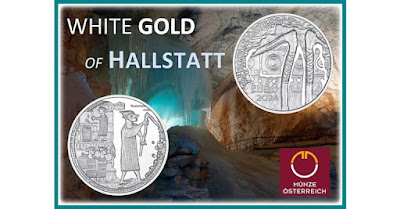3165) Bad Ischl, Salzkammergut, Republic of Austria (Osterreich Republic): Osterreich Munze (Austrian Mint) has issued a 20 Euro Silver Coin commemorating the Austrian City designated as the 2024 European Capital of Culture City: Date/Year of Coin issue: 14.02.2024:
The Header/Banner presents the Obverse and Reverse of the 20 Euro Silver coin against a background representation of the ancient Salt Mines of Hallstatt
What is the European Capitals of Culture initiative?
- It is an initiative putting culture at the heart of European cities with EU support for a yearlong celebration of art and culture.
The European Capitals of Culture (ECOC) initiative is designed to:
- Highlight the richness and diversity of cultures in Europe.
- Celebrate the cultural features Europeans share.
- Increase European citizens' sense of belonging to a common cultural area.
- Foster the contribution of culture to the development of cities.
In addition to this, experience has shown that the event is an excellent opportunity for:
- Regenerating cities
- Raising the international profile of cities
- Enhancing the image of cities in the eyes of their own inhabitants
- Breathing new life into a city's culture
- Boosting tourism
The initiative was developed in 1985 and has, to date, been awarded to more than 60 cities across the European Union (EU) and beyond.
Designation of European Capitals of Culture:
- Six years before the title year the selected host Member States publish a call for applications, usually through their Ministry for Culture. Cities interested in participating in the competition must submit a proposal for consideration.
- The submitted applications are reviewed against a set of established criteria at the end of a pre-selection phase by a panel of independent experts in the field of culture or culture-based city development. The panel agrees on a short-list of cities, which are then asked to submit more detailed applications.
- The panel then reconvenes to assess the final applications and recommends one city per host country for the title. The relevant authority in the Member State concerned then formally designates the recommended city as European Capital of Culture.
- The role of the European Commission is to ensure that the rules established at EU level are respected all along the way.
- Moreover, cities in EU candidate countries, potential candidates or members of the European Free Trade Association party to the Agreement on the European Economic Area (so-called EFTA/EEA countries) can also hold the title in 2022, 2024, 2028, 2030 and 2033. These cities are selected through an "open competition", meaning that cities from various countries may compete with each other.
Designated European Capitals of Culture:
European Capitals of Culture have already been designated until the year 2028.
They are as follows:
2024: Bad Ischl (Austria), Tartu (Estonia) and Bodø (Norway)
2025: Chemnitz (Germany) and Nova Gorica (Slovenia)
2026: Oulu (Finland) and Trenčín (Slovakia)
2027: Liepāja (Latvia) and Évora (Portugal)
2028: České Budějovice (Czech Republic), Skopje (North Macedonia, pending formal endorsement) and a city in France.
Competitions are running for title-years 2028, 2029 and 2030.
About European Capital of Culture Bad Ischl Salzkammergut (Austria):
The Capitals of Culture for 2024, alongside the Salzkammergut with 23 participating Upper Austrian and Styrian municipalities, are Tartu in Estonia and Bodø in Norway.
With the Salzkammergut and Bad Ischl as the "flagship town," an inner Alpine, rural region was named a European Capital of Culture for the first time.
Since 1985, the title of European Capital of Culture has been awarded by the European Union.
More than 60 European cities and regions have been honoured to date, including Graz (2003) and Linz (2009).
The Salzkammergut Capital of Culture region has developed four program lines that guide its agenda:
- “Power and Tradition,”
- “Culture in Motion,”
- “Sharing Salzkammergut – The Art of Travelling,” and
- “Globalocal – Building the New”.
Through numerous projects, the region presents itself, showcasing the diversity of traditional and contemporary art and culture, as well as opportunities for actively shaping the future.
Bad Ischl - The Salzkammergut's secret capital:
Bad Ischl is an imperial city, spa town and in 2024, it will be the focal point of the "European Capital of Culture Bad Ischl Salzkammergut 2024".
The symbiosis of architecture, culture and tradition reflect the history and artistic diversity of the town - pointing the way into the future.
Bad Ischl’s beauty and relaxing effect has been appreciated by holiday makers for centuries – spearheaded by Emperor Franz Franz Joseph.
Architecture in Bad Ischl:
Bad Ischl’s architecture is a mix of historic buildings, traditional Alpine architecture, and influences from various eras. The city by the river Traun is also considered the birthplace of the "Sommerfrische," a summer holiday that takes you out of the city to enjoy the cooler climate of the mountains.
The trend was started when Emperor Franz Joseph I. and Empress Sisi went there on holiday and were copied first by members of the aristocracy, then industrial magnates and finally the bourgeoisie.
Hotels, coffee houses, casinos, and promenades were built to be the new playground for Austria’s high society and onlookers from all over Europe.
Many artists, such as Anton Bruckner, Johannes Brahms and Franz Lehár, discovered the magic of a summer holiday in the countryside as well.
These holiday makers built fantastic villas for themselves, and it is these buildings that dominate the face of the town to this day.
THE WHITE GOLD OF HALLSTATT 20 EURO SILVER COIN SERIES:
In 2024, the Austrian town of Bad Ischl is European Capital of Culture, together with 22 other towns in the country’s Salzkammergut region.
To mark this momentous occasion, the Osterreich Munze (Austrian Mint) is bringing out a Coin series titled - "The White Gold of Hallstatt" commencing in February 2024, a three-piece 20 Euro Silver Series that focusses on the famous town of Hallstatt's fascinating ancient history.
Some 3,500 years ago, the richest and most technically advanced Europeans lived around Hallstatt where they mined salt, the source of their great wealth. The Coin Series will begin with "Salt Mining", which will be followed by "Salt Trading" (in November 2024) and the third and final coin in the series, "Beliefs and Rituals", in 2025.
Salt Mining, the first of three coins in "The White Gold of Hallstatt Coin Series", takes us back to a time thousands of years before the Salzkammergut region of Central Austria became a popular tourist destination and haven for nature lovers.
Astonishing archaeological finds have shown that prehistoric Hallstatt was already flourishing, as it supplied half of central Europe with that most essential of substances – Salt.
A simple and modest mining community only in appearance, prehistoric Hallstatt was highly advanced.
At the southern end of the Salzkammergut, the picture-postcard village of Hallstatt lies on the shore of the lake of the same name.
Inside the local mountains, salt is found in abundance and, exploited since prehistoric times, the Hallstatt salt mine is the world's oldest.
During the Iron Age, salt mining and trade led to the prosperity of the people in and around Hallstatt, which gave its name to the Hallstatt culture, the archaeological culture linked to the people of the Early Iron Age in Europe.
As early as 1200 BC, the tools produced for mining salt in Hallstatt were highly sophisticated and cultural exchange with other peoples led to the import of exotic materials such as amber, glass, coral and ivory from as far afield as Africa and Asia.
In the mines, the salt has preserved organic materials such as textiles, wood and leather, and artefacts decorated in styles that were widespread in Europe have survived in good condition.
20 EURO SILVER COIN "SALT MINING":
The Obverse and Reverse of the Coin titled "Salt Mining" placed side-by-side.
Salt Mining, the first of three coins in The White Gold of Hallstatt series, takes us back to a time thousands of years back in time.
Inside the local mountains, salt is found in abundance and exploited since prehistoric times, the Hallstatt salt mine is the world's oldest.
The Obverse of the Salt Mining Silver Coin features a pair of bronze pickaxes found in the prehistoric salt mines of Hallstatt.
Rocks and stones symbolising the mines are depicted around the axes and an ornamental design from the Hallstatt culture is shown in the background.
The inscriptions are - "REPUBLIK OSERREICH" (on the upper periphery) and "20 EURO. 2024" (below centre left).
The Reverse of the Salt Mining Silver Coin, in the style of a collage, is depicted a scene in which salt is mined and transported. The figures are inspired by artistic depictions found on bronze vessels from the Iron Age, in particular buckets (situlae).
Salt Mining provides a vivid picture of the prehistoric beginnings of a unique cultural and industrial landscape.
The specificatons of the 20 Euro Silver Coin are:
Country of issue: Osterreich Republik (Republic of Austria); Date of Coin Issue: 14.02.2024; Coin Denomination: 20 Euro; Coin Series Name: "The White Gold of Hallstatt"; Coin Theme: "Salt Mining"; Metal Composition: .925 Fineness Silver (Ag); Diameter/Size: 34.00 mm; Fine Weight: 0.74 g / 0.66 oz; Total Weight: 22.42 g; Coin Quality: Proof (P); Designer(s): Kathrin Kuntner, Rebecca Wilding; Packaging: Comes in a case complete with a numbered Certificate of Authenticity (COA) and protective slipcase.
The Collector Case:
Many times larger than a real grain of salt, this is a collector case like no other. Beautiful yet practical and simple yet sophisticated, it also emphasises the historical importance of salt in the development of civilisation.
Easily divisible into four parts that are held together by magnets, the crystal not only provides space for the three coins in the series but also their certificates and the companion book to the series (not included in the crystal when purchased).
A grain of salt may be tiny but the effect of salt production on human development was huge. Salt not only makes food tasty but also, and most importantly, preserves it. Preserving food is one of the oldest and most important human technologies, without which there would have been no storing and stockpiling, no abílity to plan, an even more precarious existence and an uncertain future.
The salt crystal and the treasures hidden within it also crystallise in a wonderful way what is so special about the Salzkammergut region of Austria.
Links to some more posts on the Chinese Lunar calendar/Zodiac signs on this Blog:
More posts on insect world on this blog:
i) Beetles: A set of five Post Cards issued by Chennai Postal Circle of India Post in 2017
ii) Lady Bug Beetles: A set of four Commemorative stamps brought out by India Post on 23.02.2017
Posts on "Wonderful World of Insects":
Runes:
Posts on Grimm's Fairy Tales on this Blog:
Links to "Luminous Marine Life" Coin Series:
Links: Crypto-Currency Stamps & Coin Posts:
Related Links on this Blog:






.jpg)



No comments:
Post a Comment